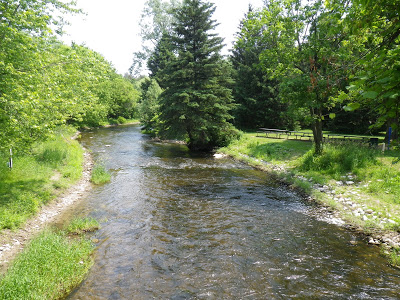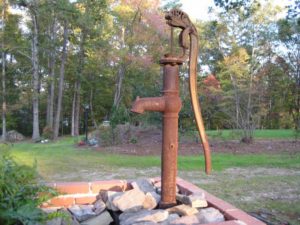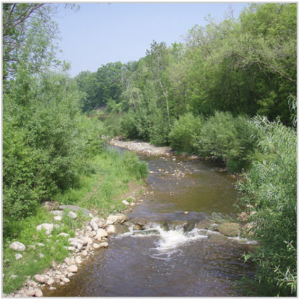 By Staff
By Staff
July 8th, 2106
BURLINGTON, ON
Conservation Halton has declared a Level I Low Water Condition for its watershed.
The low snow accumulation over the winter combined with below-normal rainfall amounts over the last three months (April, May and June) has resulted in reduced water flows and levels in local streams.

Bronte Creek is part of the Halton Region watershed – water levels are low.
Conservation Halton’s data for the month of June indicates that like much of south central Ontario, the Halton watershed has received below-average precipitation. The watershed received an average of approximately 23 mm of rain, which is only 30 per cent of the normal June average of 76 mm. The three-month average for April to June was approximately 37 mm or 47 percent of normal for this time of year. Further, the current data suggests that a number of our streams are below, or are approaching a Level II Low Water Condition threshold.
“The combination of lower snowfall amounts in winter and below-average rainfall over the last three months has resulted in the streams in the Halton watershed being lower than their typical levels for this time of the year.” said Conservation Halton Manager of Watershed Engineering Services, Janelle Weppler.
“The current situation is similar across a majority of our neighbouring watersheds and much of eastern and southwestern Ontario is in a Level I Low Water Condition with some watersheds at a Level II Low Water Condition. In light of the current conditions, our monitoring has increased and follow up discussions are being scheduled with our Low Water Response Team. ”
Under the Level I Low Water Condition, water users in the Conservation Halton watershed are asked to voluntarily conserve water with the aim of reducing overall consumption by 10 percent. The Low Water Condition is based on criteria set by the Ontario Ministry of Natural Resources & Forestry (MNRF).

If you are drawing water from a well on your property the Conservation Authority wants you to cut back by at least 10%
Water users which rely on municipal sources are not subject to these cutbacks at this time, however municipal governments, such as Halton Region, may implement water conservation measures. Conservation Halton’s watershed was last in a Level I Low Water Condition in 2012 for just over 6 months (from June to December).
The Conservation Halton watershed is comprised of the Bronte, Grindstone, and Sixteen Mile Creek watersheds that encompass portions of Puslinch, Hamilton, Halton Hills, Milton, Mississauga, Burlington and Oakville, as well as a number of smaller urban creek watersheds located in Burlington and Oakville.

Grindstone Creek also has low water levels.
A Level I condition triggers a call for a voluntary cutback of 10 per cent by users taking water from wells or surface water sources. Major water users, such as golf courses, aggregate extractors, farm irrigators and others are asked to implement or continue their water conservation programs to reach the 10 percent target. Rural water users can lower the demand on the watercourses and aquifers by pumping water at a lower rate, storing it in ponds or by staggering their pumping times in conjunction with neighbours to lower peak demand.
Conservation Halton, in partnership with the MNRF, monitors local water level and precipitation amounts. In the event of water shortages or a drought, Conservation Halton works closely with local water users and other government agencies to coordinate water conservation efforts and try to reduce demand.
Under the Province’s Ontario Low Water Response strategy, local water users and managers establish Water Response Teams (WRT) in areas experiencing low water conditions so the local community can carry out actions to reduce and better manage water use. The Low Water Response Team, coordinated by Conservation Halton in its watershed, consists of representatives from the Province, Municipalities, Conservation Authorities, local water users and industry groups. There are four levels of Low Water Conditions:
Normal – Normal Conditions are within normal limits.
Level I – First indication of potential water supply problems, primarily a warning level – key focus is on voluntary conservation of water
Level II – Indicates a potentially serious problem – conservation of water is extended to restrictions on non-essential uses
Level III – Indicates a failure of the water supply to meet demand – key focus is on conservation, regulation and enforcement of non-essential uses.
Halton’s Outdoor Water Restriction Level 1 – Blue – Careful Use
Voluntary odd/even day lawn-watering in effect.
The following outdoor water uses are allowed:
Water newly planted seed or sod.
Water trees, shrubs, flowers and gardens.
Sprinklers for recreational use.
Splash pads.
Fill swimming pools and hot tubs.
Fill garden ponds or fountains.
Wash cars.
Wash building exteriors (i.e. sheds)
Burlington fire chief issues fire ban:
The city of Burlington has banned fire pit and chimineas in the city due to hot weather.



















I don’t get it … we live beside the largest group of fresh water lakes in the world. There is no water shortage.